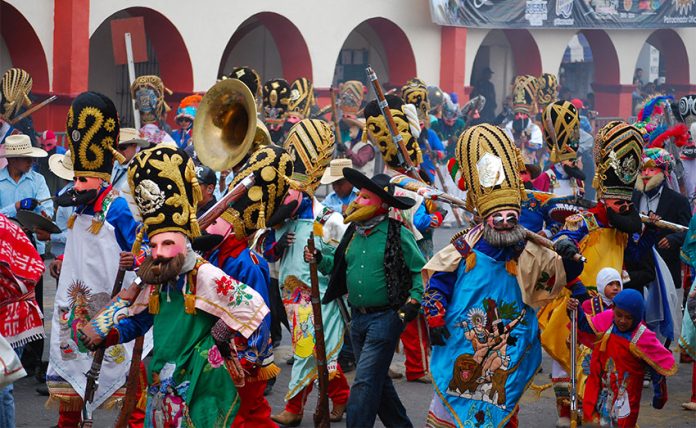Gunpowder may be heavily regulated in Mexico, but it still plays an explosive role in certain surviving traditions, often to the surprise of visitors from North America and Europe.
Such is the case at the Carnival of Huejotzingo, Puebla, which this year will be held from February 22-25. It is unique in Mexico in that it neither copies the carnivals of other countries nor features local dance. Instead, the main attraction is the mock battles very loosely based on the Battle of Puebla — the theme of the Cinco de Mayo holiday.
May 5 may not have prominence in Mexico as a whole but this date, and the battle, are very important to poblano identity.
While remembering the battle is important, this is a carnival after all so merriment still rules. The reenactments and costumes only vaguely resemble what went on that historic day.
The Huejotzingo event is the largest of Mexico’s “small” traditional carnivals — those that survived the suppression of the celebration during the colonial period. Although carnival in some form dates back farther, this version was begun in 1868, only six years after the battle.

Up to 12,000 of the town’s residents wear costumes, most to form the 17 battalions belonging to five groups. Three represent the French and their mercenary Turks (called Zuavos, Zapadores and Turcos) and two the Mexican defenders of Puebla (called Zacapoaxtlas and Indios Serranos). For three days the battle is reenacted, ending at dusk on the third day.
What grabs the attention of the over 80,000 visitors that come to Huejotzingo is the use of hand carved wooden muskets. Bullets are absent, but the gunpowder is completely real. It is not only fired off during the battles during the three days, but all day, as “soldiers” parade around constantly firing off “shots.” This means that for the entire time the air in and around the main plaza is thick with smoke and the smell of sulfur. Such firing of muskets is only done by participating townspeople but serious injury, especially to the hands, has been known to occur.
The costumes worn are either made by the participants themselves or by local craftsmen. It consists of a complete outfit, headgear, a wooden mask and a musket. These costumes are not cheap, generally ranging in value from 10,000 to 30,000 pesos (US $500 to $1,500). The most luxurious of the costumes is that of the Zacapoaxtlas.
Even children get into the act, with costumes and muskets of their own, sans the gunpowder, of course. Masks and even whole outfits are available to purchase at the carnival for both participants and spectators.
Each of the five categories of soldiers is headed by a generalísimo (high general), a role that was specifically reserved for men until 2013, when all five were headed by women.
There are two other reenactments performed during this carnival. One is the gidnapping of the mayor’s daughter, a kind of Romeo-and-Juliet-meets-Robin-Hood story. A local highway robber named Agustín Lorenzo and the mayor’s daughter fall in love and in order to marry she must be captured by Lorenzo and the couple escape the town’s posse.
Another is an imagined reenactment of the first Christian wedding of an indigenous couple shortly after the conquest. The kidnapping is performed every day of carnival, but the wedding is performed only on Sunday, Monday and Tuesday.
Unfortunately, there is no official schedule and each day is a bit different. The various events, which include more than battles, horse chases and weddings, wait in turn for the one before to finish. These events, large and small, go on nearly from daybreak to dusk with most occurring after midday.
Huejotzingo is a traditional rural community. Most of its 25,000 residents are dedicated to agriculture, manual labor and handcrafts. The town is noted for its apples, and particularly for the production of an alcoholic cider. It is home to a 16th-century monastery, part of a UNESCO World Heritage Site, but this remains severely damaged from the earthquake of 2017.
Because of significant migration from Huejotzingo and other rural areas of Puebla, versions of the event have popped up in various places in the United States, especially in the mid-Atlantic seaboard states of New York, New Jersey and Delaware, but also in Texas. This year’s New York edition of the Huejotzingo carnival will be held in Times Square.
Mexico News Daily
